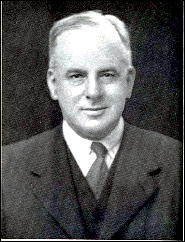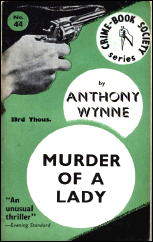Wed 22 Sep 2010
A Review by Curt Evans: ANTHONY WYNNE – Murder of a Lady (aka The Silver Scale Mystery).
Posted by Steve under Reviews[10] Comments

ANTHONY WYNNE – Murder of a Lady. Hutchinson, UK, hardcover, 1931; Crime-Book Society #44, paperback, 1930s. US title: The Silver Scale Mystery, J. B. Lippincott, hardcover, 1931.
Scottish-born physician Robert McNair Wilson (1882-1963) was a man of many interests. Besides practicing medicine, he wrote about numerous subjects, including European history, economics (his economic thought influenced the famous poet and fascist Ezra Pound and continues to attract interest at certain quarters of the internet).
More importantly, under the pseudonym Anthony Wynne, he wrote a series of twenty-seven detective novels between the years 1925 and 1950. This is the work, of course, that interests us most here at the Mystery*File blog.
Anthony Wynne’s detective novels have been out of print for sixty years, but some retain interest today. Along with John Dickson Carr, Wynne was one of the most prominent Golden Age practitioners of the locked room mystery. Unfortunately, his novels often tend to be overly melodramatic, thinly characterized and humorless, no doubt in part explaining their obscurity today.
One of the best Anthony Wynne detective novels, Murder of a Lady (The Silver Scale Mystery in the United States), deserves reprinting, however. Set in Scotland, where Wynne himself grew into adulthood, Murder of a Lady benefits from strong atmosphere (with supernatural overtones), some compelling characters and emotional entanglements, a baffling and suspenseful problem and a plausible enough solution.
The “Lady” in question, Mary Gregor, sister of a laird, is found dead by violence in her bedroom in her brother’s Highland Scottish castle. The author offers a classic sealed room situation, with locked doors and windows. More deaths occur, all seemingly impossible.

“The assassin kills but remains invisible,” announces nerve specialist Dr. Eustace Hailey, Wynne’s snuff-taking but not especially interesting series detective. In each case a herring scale is found on the victims body, a detail leading to suspicions among the superstitious locals (which includes gentry as well as plain folk) that legendary fish creatures from the nearby waters are responsible the mayhem, taking vengeance for past family misdeeds.
The crimes are truly baffling, and suspense during the investigations of both Dr. Hailey and the professionals is well maintained. The Scottish Highland atmosphere, with its supernatural elements, is very well done. (I couldn’t help but be reminded of John Dickson Carr’s The Case of the Constant Suicides, thought the humor in that book is utterly absent from Wynne’s.)
The household of the laird and his sister — which includes a son and daughter-in-law and several servants — is strongly drawn as well. Particularly admirable is the author’s delineation of the character of the first murder victim (the lady), who dominates the household even in death, a defunct spider whose victims still struggle in the remains of her web.
I was kept in suspense until the author sprang his solution, and Dr. Hailey’s explanation maintains interest until the very last paragraph of the novel, when we learn the true meaning of one element of the mystery.
Murder of a Lady is Golden Age detective fiction at its considerable best. I’m going to talk to Ramble House about getting this one reprinted.
September 22nd, 2010 at 5:27 pm
A collectors’ note first. This is a scarce book. There is one copy of the the paperback edition available for sale online, and one copy of the US hardcover. It certainly sounds as though it’s right up Ramble House’s alley.
And a detective novel in which all is not revealed until the very last paragraph, that’s my kind of detective novel!
September 22nd, 2010 at 7:04 pm
Wynne is certainly worth reading, especially his Hailey short story “The Cyprian Bees” included in Ellery Queen’s famous 101 YEARS OF ENTERTAINMENT.
Today Wynne is pretty obscure, but perhaps shouldn’t be. Admittedly some of the books are tough going, but like this one there are some gems too.
Thanks Curt for reviewing this one. I’d love to see this and a few other Wynne’s brought back in print — and I admit, I liked some of the melodrama.
September 22nd, 2010 at 11:18 pm
This is my personal favorite by the author, have not read them all, however.
September 23rd, 2010 at 5:59 pm
I find Wynne’s novels to be tough sledding, but his short stories are, IMHO, much better; some were collected in SINNERS GO SECRETLY great title!) in 1927. Tony Medawar told me that a number of uncollected stories remain.
September 23rd, 2010 at 6:48 pm
Doug
Regarding your last sentence: Maybe you and Tony could do something about that?
— Steve
September 23rd, 2010 at 8:03 pm
That’s very interesting, Doug. I wondered why there was this one volume of short stories from the mid-20s and nothing else, despite the fact that he wrote more novels over a 20+ year period.
I’ll say again, I think Murder of a Lady is excellent. People who dislike the “Humdrums” because they feel they don’t put enough emphasis on surprise won’t have that problem with Lady, which teases both the who? and how? questions very nicely. Plus the atmosphere is notable and there’s some good psychology.
September 23rd, 2010 at 8:04 pm
By the way, Doug, I located a grandson of Wilson’s, if you ever need to get in touch!
September 29th, 2010 at 8:09 pm
[…] is not as good a detective novel, in my opinion, as Murder of a Lady, reviewed here. The setting and characters are less original and the likely identity of the key culprit should not […]
August 9th, 2016 at 9:54 am
What a wonderful find! Found this delightful mystery in my local library, and throughly enjoyed the setting, the characters and the solving of the murder. I’m glad to see it was reprinted by Poisoned Pen Press in 2016.
April 6th, 2020 at 4:44 am
[…] Under the pseudonym Anthony Wynne, he wrote a series of twenty-seven detective novels between the years 1925 and 1950. . . . . Anthony Wynne’s detective novels have been out of print for sixty years, but some retain interest today. Along with John Dickson Carr, Wynne was one of the most prominent Golden Age practitioners of the locked room mystery. Unfortunately, his novels often tend to be overly melodramatic, thinly characterized and humorless, no doubt in part explaining their obscurity today. One of the best Anthony Wynne detective novels, Murder of a Lady (The Silver Scale Mystery in the United States), deserves reprinting, however. Set in Scotland, where Wynne himself grew into adulthood, Murder of a Lady benefits from strong atmosphere (with supernatural overtones), some compelling characters and emotional entanglements, a baffling and suspenseful problem and a plausible enough solution. Keep reading here. […]